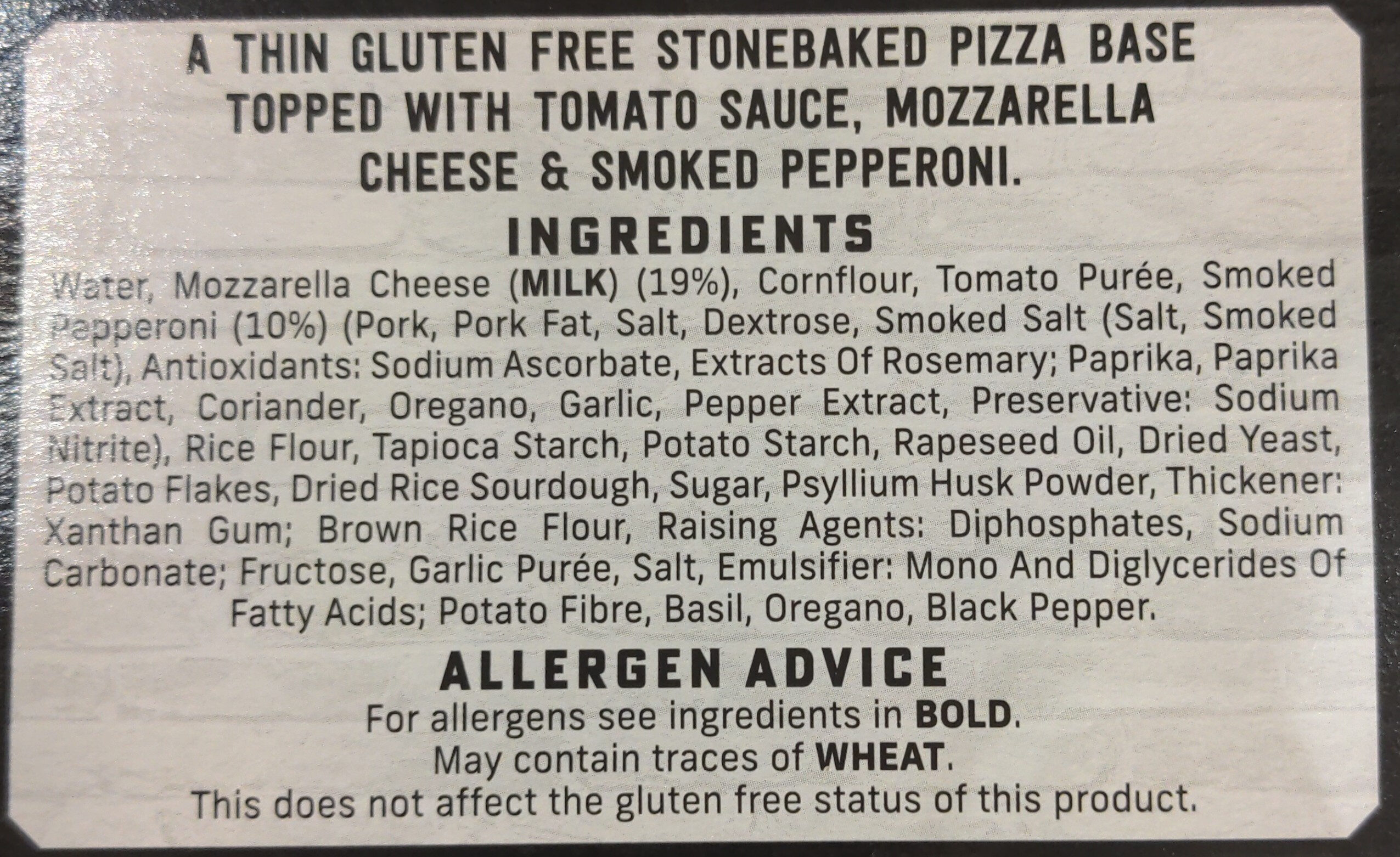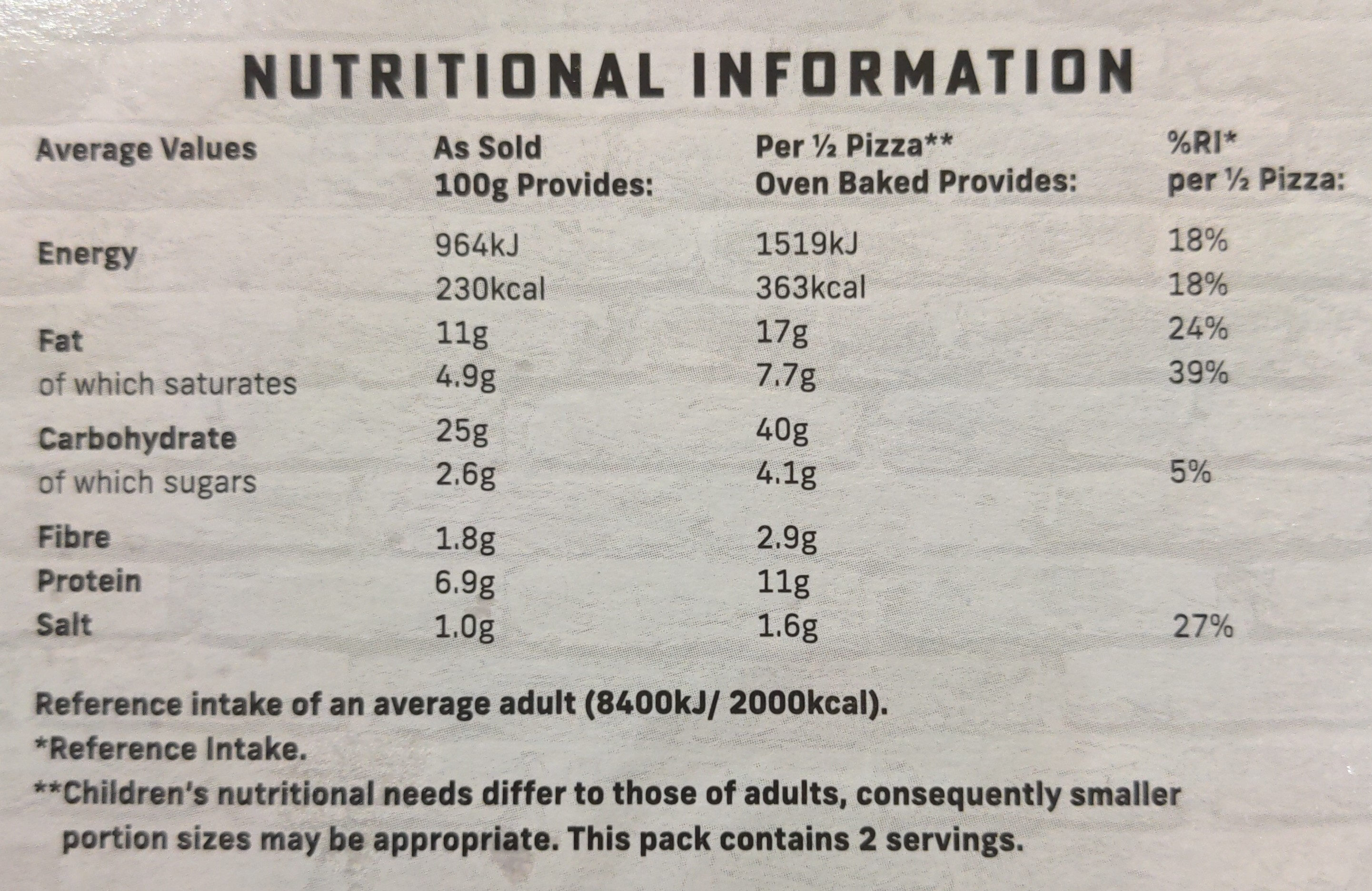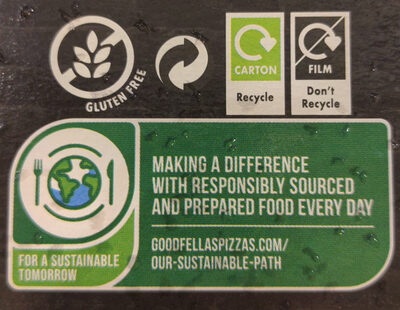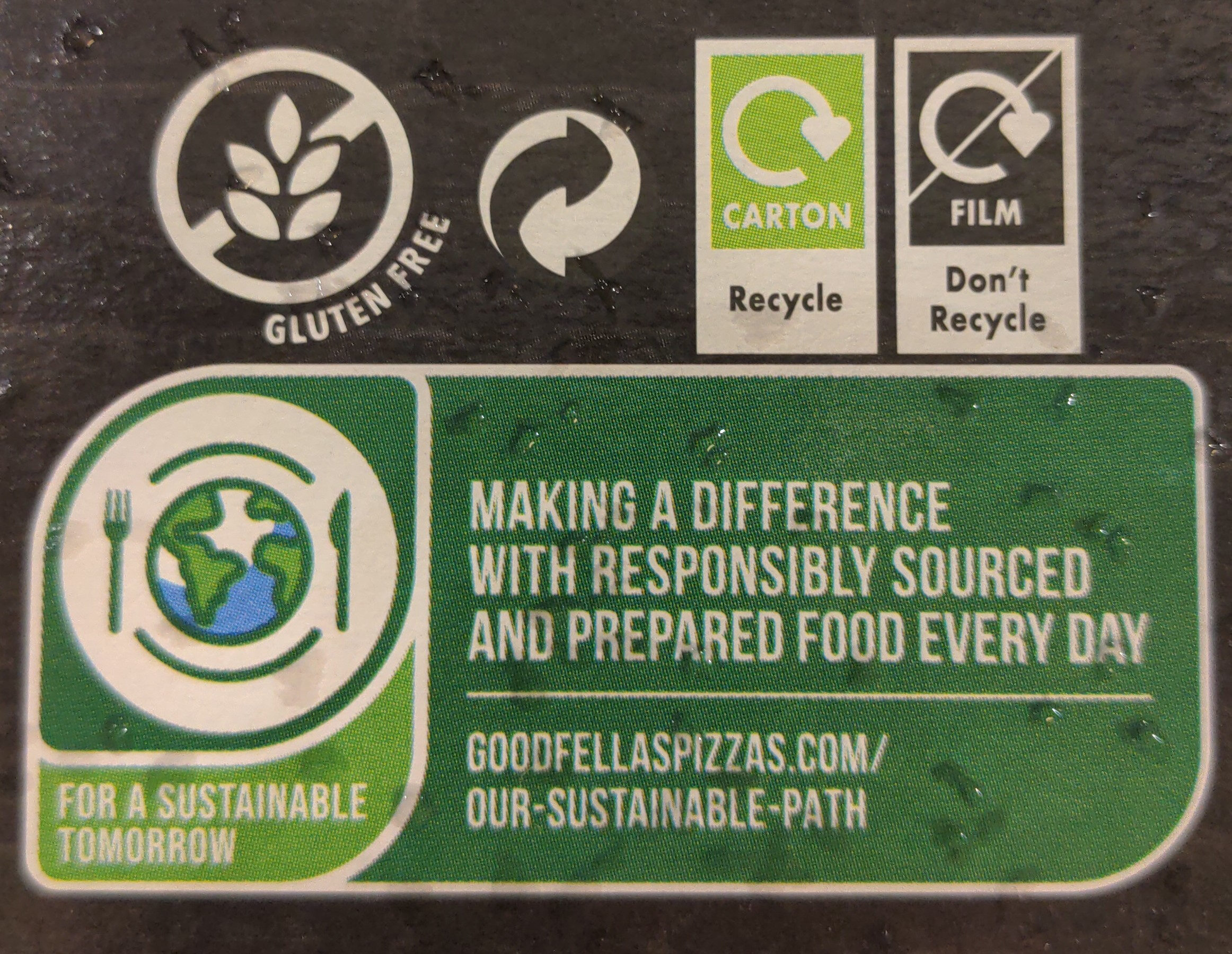Help us make food transparency the norm!
As a non-profit organization, we depend on your donations to continue informing consumers around the world about what they eat.
The food revolution starts with you!
Gluten free pepperoni - Goodfellas - 317g
Gluten free pepperoni - Goodfellas - 317g
This product page is not complete. You can help to complete it by editing it and adding more data from the photos we have, or by taking more photos using the app for Android or iPhone/iPad. Thank you!
×
Barcode: 5391527000259 (EAN / EAN-13)
Quantity: 317g
Packaging: Card-box, Mixed plastic film-sleeve
Brands: Goodfellas
Categories: Plant-based foods and beverages, Plant-based foods, Cereals and potatoes, Cereals and their products, Specific products, Pastas, Products for specific diets, Products without gluten, Gluten-free pasta, Gluten-free tagliatelles
Labels, certifications, awards: No gluten
Countries where sold: Ireland
Matching with your preferences
Health
Ingredients
-
47 ingredients
water, mozzarella cheese (milk) (19%), cornflour, tomato purée, smoked papperoni (10%) (pork, pork fat, salt, dextrose, smoked salt (salt, smoked salt), antioxidants: sodium ascorbate, extracts of rosemary, paprika, paprika extract, coriander, oregano, garlic, pepper extract, preservative: sodium nitrite), rice flour, tapioca starch, potato starch, rapeseed oil, dried yeast, potato flakes, dried rice sourdough, sugar, psyllium husk powder, thickener: xanthan gum, brown rice flour, raising agents: diphosphates, sodium carbonate, fructose, garlic purée, salt, emulsifier: mono and diglycerides of fatty acids, potato fibre, basil, oregano, black pepperAllergens: Milk, PorkTraces: Gluten
Food processing
-
Ultra processed foods
Elements that indicate the product is in the 4 - Ultra processed food and drink products group:
- Additive: E160c - Paprika extract
- Additive: E415 - Xanthan gum
- Additive: E450 - Diphosphates
- Additive: E471 - Mono- and diglycerides of fatty acids
- Ingredient: Dextrose
- Ingredient: Emulsifier
- Ingredient: Glucose
- Ingredient: Thickener
Food products are classified into 4 groups according to their degree of processing:
- Unprocessed or minimally processed foods
- Processed culinary ingredients
- Processed foods
- Ultra processed foods
The determination of the group is based on the category of the product and on the ingredients it contains.
Additives
-
E250 - Sodium nitrite
Sodium nitrite: Sodium nitrite is the inorganic compound with the chemical formula NaNO2. It is a white to slightly yellowish crystalline powder that is very soluble in water and is hygroscopic. It is a useful precursor to a variety of organic compounds, such as pharmaceuticals, dyes, and pesticides, but it is probably best known as a food additive to prevent botulism. It is on the World Health Organization's List of Essential Medicines, the most important medications needed in a basic health system.Nitrate or nitrite -ingested- under conditions that result in endogenous nitrosation has been classified as "probably carcinogenic to humans" by International Agency for Research on Cancer -IARC-.Source: Wikipedia
-
E301 - Sodium ascorbate
Sodium ascorbate: Sodium ascorbate is one of a number of mineral salts of ascorbic acid -vitamin C-. The molecular formula of this chemical compound is C6H7NaO6. As the sodium salt of ascorbic acid, it is known as a mineral ascorbate. It has not been demonstrated to be more bioavailable than any other form of vitamin C supplement.Sodium ascorbate normally provides 131 mg of sodium per 1‚000 mg of ascorbic acid -1‚000 mg of sodium ascorbate contains 889 mg of ascorbic acid and 111 mg of sodium-. As a food additive, it has the E number E301 and is used as an antioxidant and an acidity regulator. It is approved for use as a food additive in the EU, USA, and Australia and New Zealand.In in vitro studies, sodium ascorbate has been found to produce cytotoxic effects in various malignant cell lines, which include melanoma cells that are particularly susceptible.Source: Wikipedia
-
E415 - Xanthan gum
Xanthan gum (E415) is a natural polysaccharide derived from fermented sugars, often used in the food industry as a thickening and stabilizing agent.
This versatile food additive enhances texture and prevents ingredient separation in a wide range of products, including salad dressings, sauces, and gluten-free baked goods.
It is considered safe for consumption even at high intake amounts.
-
E450 - Diphosphates
Diphosphates (E450) are food additives often utilized to modify the texture of products, acting as leavening agents in baking and preventing the coagulation of canned food.
These salts can stabilize whipped cream and are also found in powdered products to maintain their flow properties. They are commonly present in baked goods, processed meats, and soft drinks.
Derived from phosphoric acid, they're part of our daily phosphate intake, which often surpasses recommended levels due to the prevalence of phosphates in processed foods and drinks.
Excessive phosphate consumption is linked to health issues, such as impaired kidney function and weakened bone health. Though diphosphates are generally regarded as safe when consumed within established acceptable daily intakes, it's imperative to monitor overall phosphate consumption to maintain optimal health.
-
E471 - Mono- and diglycerides of fatty acids
Mono- and diglycerides of fatty acids (E471), are food additives commonly used as emulsifiers in various processed foods.
These compounds consist of glycerol molecules linked to one or two fatty acid chains, which help stabilize and blend water and oil-based ingredients. E471 enhances the texture and shelf life of products like margarine, baked goods, and ice cream, ensuring a smooth and consistent texture.
It is generally considered safe for consumption within established regulatory limits.
-
E500 - Sodium carbonates
Sodium carbonates (E500) are compounds commonly used in food preparation as leavening agents, helping baked goods rise by releasing carbon dioxide when they interact with acids.
Often found in baking soda, they regulate the pH of food, preventing it from becoming too acidic or too alkaline. In the culinary world, sodium carbonates can also enhance the texture and structure of foods, such as noodles, by modifying the gluten network.
Generally recognized as safe, sodium carbonates are non-toxic when consumed in typical amounts found in food.
-
E500i - Sodium carbonate
Sodium carbonate: Sodium carbonate, Na2CO3, -also known as washing soda, soda ash and soda crystals, and in the monohydrate form as crystal carbonate- is the water-soluble sodium salt of carbonic acid. It most commonly occurs as a crystalline decahydrate, which readily effloresces to form a white powder, the monohydrate. Pure sodium carbonate is a white, odorless powder that is hygroscopic -absorbs moisture from the air-. It has a strongly alkaline taste, and forms a moderately basic solution in water. Sodium carbonate is well known domestically for its everyday use as a water softener. Historically it was extracted from the ashes of plants growing in sodium-rich soils, such as vegetation from the Middle East, kelp from Scotland and seaweed from Spain. Because the ashes of these sodium-rich plants were noticeably different from ashes of timber -used to create potash-, they became known as "soda ash". It is synthetically produced in large quantities from salt -sodium chloride- and limestone by a method known as the Solvay process. The manufacture of glass is one of the most important uses of sodium carbonate. Sodium carbonate acts as a flux for silica, lowering the melting point of the mixture to something achievable without special materials. This "soda glass" is mildly water-soluble, so some calcium carbonate is added to the melt mixture to make the glass produced insoluble. This type of glass is known as soda lime glass: "soda" for the sodium carbonate and "lime" for the calcium carbonate. Soda lime glass has been the most common form of glass for centuries. Sodium carbonate is also used as a relatively strong base in various settings. For example, it is used as a pH regulator to maintain stable alkaline conditions necessary for the action of the majority of photographic film developing agents. It acts as an alkali because when dissolved in water, it dissociates into the weak acid: carbonic acid and the strong alkali: sodium hydroxide. This gives sodium carbonate in solution the ability to attack metals such as aluminium with the release of hydrogen gas.It is a common additive in swimming pools used to raise the pH which can be lowered by chlorine tablets and other additives which contain acids. In cooking, it is sometimes used in place of sodium hydroxide for lyeing, especially with German pretzels and lye rolls. These dishes are treated with a solution of an alkaline substance to change the pH of the surface of the food and improve browning. In taxidermy, sodium carbonate added to boiling water will remove flesh from the bones of animal carcasses for trophy mounting or educational display. In chemistry, it is often used as an electrolyte. Electrolytes are usually salt-based, and sodium carbonate acts as a very good conductor in the process of electrolysis. In addition, unlike chloride ions, which form chlorine gas, carbonate ions are not corrosive to the anodes. It is also used as a primary standard for acid-base titrations because it is solid and air-stable, making it easy to weigh accurately.Source: Wikipedia
Ingredients analysis
-
May contain palm oil
Ingredients that may contain palm oil: Pork fat, E471
-
Non-vegan
Non-vegan ingredients: Mozzarella, Pork, Pork fatSome ingredients could not be recognized.
We need your help!
You can help us recognize more ingredients and better analyze the list of ingredients for this product and others:
- Edit this product page to correct spelling mistakes in the ingredients list, and/or to remove ingredients in other languages and sentences that are not related to the ingredients.
- Add new entries, synonyms or translations to our multilingual lists of ingredients, ingredient processing methods, and labels.
If you would like to help, join the #ingredients channel on our Slack discussion space and/or learn about ingredients analysis on our wiki. Thank you!
-
Non-vegetarian
Non-vegetarian ingredients: Pork, Pork fatSome ingredients could not be recognized.
We need your help!
You can help us recognize more ingredients and better analyze the list of ingredients for this product and others:
- Edit this product page to correct spelling mistakes in the ingredients list, and/or to remove ingredients in other languages and sentences that are not related to the ingredients.
- Add new entries, synonyms or translations to our multilingual lists of ingredients, ingredient processing methods, and labels.
If you would like to help, join the #ingredients channel on our Slack discussion space and/or learn about ingredients analysis on our wiki. Thank you!
-
Details of the analysis of the ingredients
We need your help!
Some ingredients could not be recognized.
We need your help!
You can help us recognize more ingredients and better analyze the list of ingredients for this product and others:
- Edit this product page to correct spelling mistakes in the ingredients list, and/or to remove ingredients in other languages and sentences that are not related to the ingredients.
- Add new entries, synonyms or translations to our multilingual lists of ingredients, ingredient processing methods, and labels.
If you would like to help, join the #ingredients channel on our Slack discussion space and/or learn about ingredients analysis on our wiki. Thank you!
en: water, mozzarella cheese, cornflour, tomato purée, smoked papperoni 10% (pork, pork fat, salt, dextrose, smoked salt (salt, smoked salt), antioxidants (sodium ascorbate), extracts of rosemary, paprika, paprika extract, coriander, oregano, garlic, pepper extract, preservative (sodium nitrite)), rice flour, tapioca starch, potato starch, rapeseed oil, yeast, potato flakes, dried rice sourdough, sugar, psyllium husk, thickener (xanthan gum), brown rice flour, raising agents (diphosphates), sodium carbonate, fructose, garlic purée, salt, emulsifier (mono- and diglycerides of fatty acids), potato fibre, basil, oregano, black pepper- water -> en:water - vegan: yes - vegetarian: yes - ciqual_food_code: 18066 - percent_min: 10 - percent_max: 60
- mozzarella cheese -> en:mozzarella - vegan: no - vegetarian: maybe - ciqual_food_code: 19590 - percent_min: 10 - percent_max: 35
- cornflour -> en:corn-flour - vegan: yes - vegetarian: yes - ciqual_food_code: 9545 - percent_min: 10 - percent_max: 26.6666666666667
- tomato purée -> en:tomato-puree - vegan: yes - vegetarian: yes - ciqual_food_code: 20170 - percent_min: 10 - percent_max: 22.5
- smoked papperoni -> en:smoked-papperoni - percent_min: 10 - percent: 10 - percent_max: 10
- pork -> en:pork - vegan: no - vegetarian: no - percent_min: 0.714285714285714 - percent_max: 10
- pork fat -> en:pork-fat - vegan: no - vegetarian: no - from_palm_oil: maybe - ciqual_food_code: 16530 - percent_min: 0 - percent_max: 5
- salt -> en:salt - vegan: yes - vegetarian: yes - ciqual_food_code: 11058 - percent_min: 0 - percent_max: 1
- dextrose -> en:dextrose - vegan: yes - vegetarian: yes - ciqual_proxy_food_code: 31016 - percent_min: 0 - percent_max: 1
- smoked salt -> en:smoked-salt - vegan: yes - vegetarian: yes - ciqual_food_code: 11058 - percent_min: 0 - percent_max: 1
- salt -> en:salt - vegan: yes - vegetarian: yes - ciqual_food_code: 11058 - percent_min: 0 - percent_max: 1
- smoked salt -> en:smoked-salt - vegan: yes - vegetarian: yes - ciqual_food_code: 11058 - percent_min: 0 - percent_max: 0.5
- antioxidants -> en:antioxidant - percent_min: 0 - percent_max: 1
- sodium ascorbate -> en:e301 - vegan: yes - vegetarian: yes - percent_min: 0 - percent_max: 1
- extracts of rosemary -> en:e392 - vegan: yes - vegetarian: yes - percent_min: 0 - percent_max: 1
- paprika -> en:paprika - vegan: yes - vegetarian: yes - ciqual_food_code: 11049 - percent_min: 0 - percent_max: 1
- paprika extract -> en:e160c - vegan: yes - vegetarian: yes - percent_min: 0 - percent_max: 1
- coriander -> en:coriander - vegan: yes - vegetarian: yes - percent_min: 0 - percent_max: 1
- oregano -> en:oregano - vegan: yes - vegetarian: yes - ciqual_proxy_food_code: 11035 - percent_min: 0 - percent_max: 1
- garlic -> en:garlic - vegan: yes - vegetarian: yes - ciqual_food_code: 11000 - percent_min: 0 - percent_max: 0.833333333333333
- pepper extract -> en:pepper-extract - vegan: yes - vegetarian: yes - percent_min: 0 - percent_max: 0.833333333333333
- preservative -> en:preservative - percent_min: 0 - percent_max: 0.714285714285714
- sodium nitrite -> en:e250 - vegan: yes - vegetarian: yes - percent_min: 0 - percent_max: 0.714285714285714
- rice flour -> en:rice-flour - vegan: yes - vegetarian: yes - ciqual_food_code: 9520 - percent_min: 0 - percent_max: 10
- tapioca starch -> en:tapioca - vegan: yes - vegetarian: yes - ciqual_proxy_food_code: 9510 - percent_min: 0 - percent_max: 10
- potato starch -> en:potato-starch - vegan: yes - vegetarian: yes - ciqual_proxy_food_code: 9510 - percent_min: 0 - percent_max: 10
- rapeseed oil -> en:rapeseed-oil - vegan: yes - vegetarian: yes - from_palm_oil: no - percent_min: 0 - percent_max: 8.57142857142857
- yeast -> en:yeast - vegan: yes - vegetarian: yes - percent_min: 0 - percent_max: 7.5
- potato flakes -> en:potato-flakes - vegan: yes - vegetarian: yes - ciqual_food_code: 4003 - percent_min: 0 - percent_max: 6.66666666666667
- dried rice sourdough -> en:dried-rice-sourdough - percent_min: 0 - percent_max: 6
- sugar -> en:sugar - vegan: yes - vegetarian: yes - ciqual_proxy_food_code: 31016 - percent_min: 0 - percent_max: 2.6
- psyllium husk -> en:psyllium - vegan: yes - vegetarian: yes - percent_min: 0 - percent_max: 2.6
- thickener -> en:thickener - percent_min: 0 - percent_max: 2.6
- xanthan gum -> en:e415 - vegan: yes - vegetarian: yes - percent_min: 0 - percent_max: 2.6
- brown rice flour -> en:brown-rice-flour - vegan: yes - vegetarian: yes - ciqual_food_code: 9520 - percent_min: 0 - percent_max: 2.6
- raising agents -> en:raising-agent - percent_min: 0 - percent_max: 2.6
- diphosphates -> en:e450 - vegan: yes - vegetarian: yes - percent_min: 0 - percent_max: 2.6
- sodium carbonate -> en:e500i - vegan: yes - vegetarian: yes - percent_min: 0 - percent_max: 2.6
- fructose -> en:fructose - vegan: yes - vegetarian: yes - ciqual_food_code: 31077 - percent_min: 0 - percent_max: 2.6
- garlic purée -> en:garlic-puree - vegan: yes - vegetarian: yes - ciqual_food_code: 11000 - percent_min: 0 - percent_max: 2.6
- salt -> en:salt - vegan: yes - vegetarian: yes - ciqual_food_code: 11058 - percent_min: 0 - percent_max: 1
- emulsifier -> en:emulsifier - percent_min: 0 - percent_max: 1
- mono- and diglycerides of fatty acids -> en:e471 - vegan: maybe - vegetarian: maybe - from_palm_oil: maybe - percent_min: 0 - percent_max: 1
- potato fibre -> en:potato-fiber - vegan: yes - vegetarian: yes - percent_min: 0 - percent_max: 1
- basil -> en:basil - vegan: yes - vegetarian: yes - ciqual_food_code: 11033 - percent_min: 0 - percent_max: 1
- oregano -> en:oregano - vegan: yes - vegetarian: yes - ciqual_proxy_food_code: 11035 - percent_min: 0 - percent_max: 1
- black pepper -> en:black-pepper - vegan: yes - vegetarian: yes - ciqual_food_code: 11015 - percent_min: 0 - percent_max: 1
Nutrition
-
Average nutritional quality
⚠ ️Warning: the amount of fruits, vegetables and nuts is not specified on the label, it was estimated from the list of ingredients: 16This product is not considered a beverage for the calculation of the Nutri-Score.
Positive points: 5
- Proteins: 4 / 5 (value: 6.9, rounded value: 6.9)
- Fiber: 1 / 5 (value: 1.8, rounded value: 1.8)
- Fruits, vegetables, nuts, and colza/walnut/olive oils: 0 / 5 (value: 16.2531273251488, rounded value: 16.3)
Negative points: 10
- Energy: 2 / 10 (value: 925, rounded value: 925)
- Sugars: 0 / 10 (value: 2.6, rounded value: 2.6)
- Saturated fat: 4 / 10 (value: 4.9, rounded value: 4.9)
- Sodium: 4 / 10 (value: 400, rounded value: 400)
The points for proteins are counted because the negative points are less than 11.
Nutritional score: (10 - 5)
Nutri-Score:
-
Nutrient levels
-
Fat in moderate quantity (10%)
What you need to know- A high consumption of fat, especially saturated fats, can raise cholesterol, which increases the risk of heart diseases.
Recommendation: Limit the consumption of fat and saturated fat- Choose products with lower fat and saturated fat content.
-
Saturated fat in moderate quantity (4.9%)
What you need to know- A high consumption of fat, especially saturated fats, can raise cholesterol, which increases the risk of heart diseases.
Recommendation: Limit the consumption of fat and saturated fat- Choose products with lower fat and saturated fat content.
-
Sugars in low quantity (2.6%)
What you need to know- A high consumption of sugar can cause weight gain and tooth decay. It also augments the risk of type 2 diabetes and cardio-vascular diseases.
Recommendation: Limit the consumption of sugar and sugary drinks- Sugary drinks (such as sodas, fruit beverages, and fruit juices and nectars) should be limited as much as possible (no more than 1 glass a day).
- Choose products with lower sugar content and reduce the consumption of products with added sugars.
-
Salt in moderate quantity (1%)
What you need to know- A high consumption of salt (or sodium) can cause raised blood pressure, which can increase the risk of heart disease and stroke.
- Many people who have high blood pressure do not know it, as there are often no symptoms.
- Most people consume too much salt (on average 9 to 12 grams per day), around twice the recommended maximum level of intake.
Recommendation: Limit the consumption of salt and salted food- Reduce the quantity of salt used when cooking, and don't salt again at the table.
- Limit the consumption of salty snacks and choose products with lower salt content.
-
-
Nutrition facts
Nutrition facts As sold
for 100 g / 100 mlAs sold
per serving (317g)Compared to: Gluten-free pasta Energy 925 kj
(221 kcal)2,930 kj
(701 kcal)-36% Fat 10 g 31.7 g +415% Saturated fat 4.9 g 15.5 g +1,045% Carbohydrates 25 g 79.2 g -63% Sugars 2.6 g 8.24 g +139% Fiber 1.8 g 5.71 g -55% Proteins 6.9 g 21.9 g -31% Salt 1 g 3.17 g +3,688% Fruits‚ vegetables‚ nuts and rapeseed‚ walnut and olive oils (estimate from ingredients list analysis) 16.253 % 16.253 %
Environment
-
Eco-Score not computed - Unknown environmental impact
We could not compute the Eco-Score of this product as it is missing some data, could you help complete it?Could you add a precise product category so that we can compute the Eco-Score? Add a category
Packaging
-
Packaging with a high impact
-
Packaging parts
Sleeve (Plastic)
Box
-
Packaging materials
Material % Packaging weight Packaging weight per 100 g of product Plastic
-
Transportation
-
Origins of ingredients
Missing origins of ingredients information
⚠ ️ The origins of the ingredients of this product are not indicated.
If they are indicated on the packaging, you can modify the product sheet and add them.
If you are the manufacturer of this product, you can send us the information with our free platform for producers.Add the origins of ingredients for this product Add the origins of ingredients for this product
Report a problem
-
Incomplete or incorrect information?
Category, labels, ingredients, allergens, nutritional information, photos etc.
If the information does not match the information on the packaging, please complete or correct it. Open Food Facts is a collaborative database, and every contribution is useful for all.
Data sources
Product added on by kiliweb
Last edit of product page on by inf.
Product page also edited by ciandonovan, packbot, roboto-app, swipe-studio, yuka.sY2b0xO6T85zoF3NwEKvlmpYA4fQjCjBZi3gmEa61-qNFbHPMdtv77bbCKs, yuka.sY2b0xO6T85zoF3NwEKvlnFLesjAoRjHbRvignaAlsaDF57GOetS067DHKo, yuka.sY2b0xO6T85zoF3NwEKvlnxjdPv8hBz7HCTTmE2l79SMJ77YO_Mu5dD5Gao.












